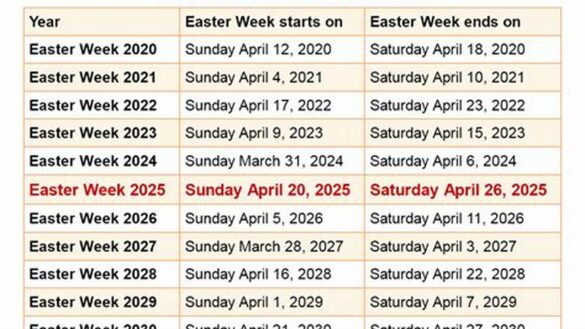Easter Sunday is a cornerstone date in the Christian calendar, marking the celebration of the resurrection of Jesus Christ from the dead. This event is considered the culmination of Holy Week, which begins with Palm Sunday and includes Good Friday, the day of Christ’s crucifixion. However, unlike Christmas, which falls on December 25, the date of Easter Sunday is not fixed. Its variability can be perplexing and, at times, a source of intrigue. So, when is Easter Sunday each year? Are you ready to embark on a quest through time to discover the dates from 2020 to 2030? Let’s delve into the mystical and mathematical calculations that determine the date of this significant feast.
The formula for determining Easter is rooted in both lunar cycles and ecclesiastical approximation of the March equinox. In essence, Easter is celebrated on the first Sunday following the full moon that occurs on or after the vernal equinox, which is fixed on March 21. This means the earliest possible date for Easter is March 22, and the latest is April 25. Such an intricate calculation imbues the holiday with a celestial rhythm that resonates through the ages.
The dates for Easter Sunday from 2020 to 2030 are as follows:
- 2020: April 12
- 2021: April 4
- 2022: April 17
- 2023: April 9
- 2024: March 31
- 2025: April 20
- 2026: April 5
- 2027: March 28
- 2028: April 16
- 2029: April 1
- 2030: April 21
While these dates may seem arbitrary at first glance, they are imbued with significant meaning and historical context within the Christian tradition. Each year, the church prepares for this holy occasion with anticipation and intricate observances. The weeks leading up to Easter are deeply rooted in reflection and penitence, culminating in the joyous celebration of the resurrection. As Christians around the world gather to remember this pivotal moment in their faith, a sense of unity and purpose emerges, transcending cultural and geographical boundaries.
The colorful rituals associated with Easter, such as the observance of Lent, Good Friday services, and the Easter Vigil, all serve to enhance the spiritual experience. Lent, a 40-day period of fasting and repentance, invites adherents to introspection and faith renewal. It allows Christians to draw parallel experiences to Jesus’ own 40 days of fasting in the wilderness, fostering a deeper understanding of sacrifice and redemption. Do you ever wonder how many of us pause to consider the profound significance behind the eggs we decorate or the bunnies we chase during this time? Each symbol carries layers of historical and theological meaning, merging pagan springtime customs with the central tenets of Christianity.
But what about the variations within different Christian denominations regarding Easter celebrations? Eastern Orthodox Christians, for instance, practice a slightly different calculation based on the Julian calendar, resulting in Easter dates that often diverge from those in Western Christianity. This divergence can ignite a playful debate among friends and family regarding the “true” date of Easter. It encourages inquiry into the rich tapestry of Christian traditions and how interpretations may shift across the globe.
Another intriguing aspect of Easter is the myriad practices that accompany this holy day. In some cultures, the Easter Sunrise Service emerges as a cherished tradition. As dawn breaks, congregants come together to commemorate the resurrection, mirroring the biblical account of the empty tomb discovered by Mary Magdalene and others. The beauty of the rising sun is a powerful metaphor for rebirth and new beginnings, reinforcing themes of hope and renewal.
As you peruse the dates and reflect upon the traditions, a contemplative challenge arises. How do these annual observances transform your understanding of faith? Do these transient yet profound moments lead to an evolution in your spiritual journey? Each Easter serves as a reminder of resilience, a narrative that invites believers to confront their mortality and celebrate the beatific promise of eternal life.
The movement of these dates reiterates the connection between time, faith, and the universe. The celestial mechanics that dictate the timing of Easter engage our curiosity and beckon our reflections on life’s larger questions. 2025’s Easter, for instance, will be celebrated on April 20. Reflecting on that date offers an opportunity to envision what your life may manifest in the years that lead up to it. What aspirations can be realized in the lead-up to this significant occasion?
In summation, the determination of Easter Sunday is a complex interplay of historical, astronomical, and theological elements that engage the heart and mind. From 2020 to 2030, each date is more than just a calendar mark; it is an invitation to experience the joy, sorrow, and ultimate triumph of the Christian faith. As the world turns and seasons change, the constancy of our traditions allows us to connect with generations past and those yet to come. Embrace this cycle—contemplate, engage, and celebrate the essence of Easter in all its multifaceted glory.



